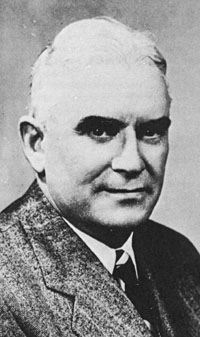Byron Ingemar Johnson
| Boss Johnson | |
|---|---|

Byron I. Johnson
|
|
| 24th Premier of British Columbia | |
|
In office December 29, 1947 – August 1, 1952 |
|
| Monarch |
George VI Elizabeth II |
| Lieutenant Governor |
Charles Arthur Banks Clarence Wallace |
| Preceded by | John Hart |
| Succeeded by | W. A. C. Bennett |
| MLA for Victoria City | |
|
In office November 2, 1933 – June 1, 1937 Serving with Herbert Anscomb, Robert Connell, John Hart |
|
| Preceded by |
James Harry Beatty Reginald Hayward Joshua Hinchcliffe Harold Despard Twigg |
| Succeeded by | Joseph Douglas Hunter |
| MLA for New Westminster | |
|
In office October 25, 1945 – June 12, 1952 |
|
| Preceded by | Arthur Wellesley Gray |
| Succeeded by | Rae Eddie |
| Personal details | |
| Born |
Björn Ingimar Jónsson December 10, 1890 Victoria, British Columbia |
| Died | January 12, 1964 (aged 73) Victoria, British Columbia |
| Political party | Coalition government of British Columbia Liberal Party and British Columbia Conservative Party |
| Spouse(s) | Kate Johnson |
| Religion | United Church |
Byron Ingemar "Boss" Johnson (December 10, 1890 – January 12, 1964), born Björn Ingimar "Bjössi" Jónsson, served as the 24th Premier of the province of British Columbia, Canada, from 1947 to 1952. To his contemporaries he was often referred to by his nickname, Boss Johnson, which had nothing to do with his personality, but was an anglicization of the Icelandic "Bjossi", which is a diminutive form of his birth-name of Bjorn, which was adapted into English as Byron.
Johnson was born and raised in Victoria, British Columbia. After overseas service in World War I, he and his brothers opened a building supplies business in Victoria, which proved to be successful. Johnson was first elected as one of four Members of the Legislative Assembly from Victoria City to the BC Legislature as a Liberal in the 1933 election. He served four years in the caucus of Premier Duff Pattullo before being defeated in the 1937 election.
Johnson returned to his business, and in World War II was put in charge of constructing Royal Canadian Air Force facilities throughout the province. In the 1945 election, he returned to the legislature, this time as the member for New Westminster, becoming a cabinet minister in the coalition government formed by the Liberal and Conservative parties, and led by Premier John Hart. Following Hart's resignation in 1947, Johnson succeeded him as Liberal leader and as the leader of the Coalition, and therefore also as Premier - becoming the first Premier of British Columbia born after confederation in the province.
...
Wikipedia
